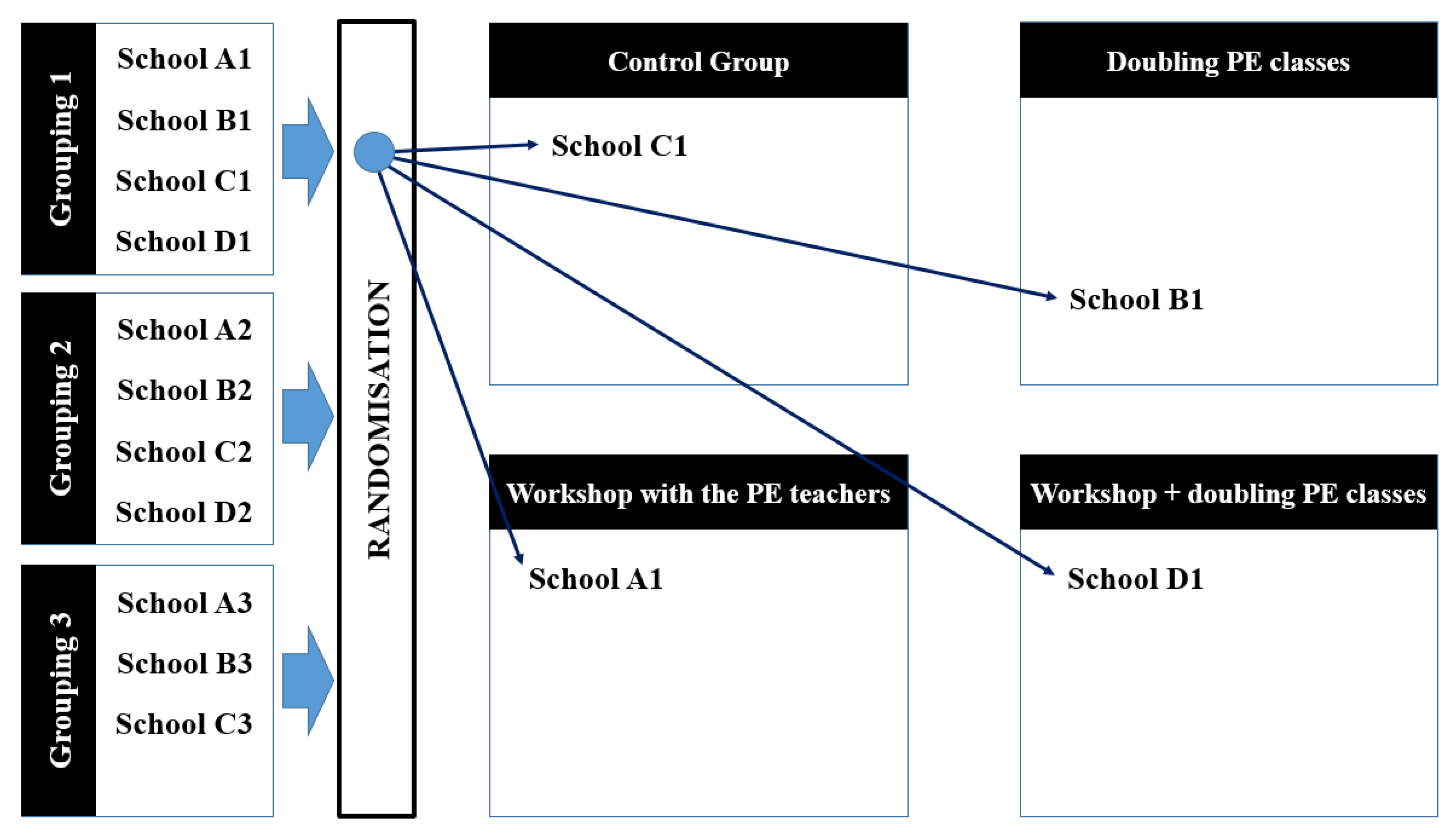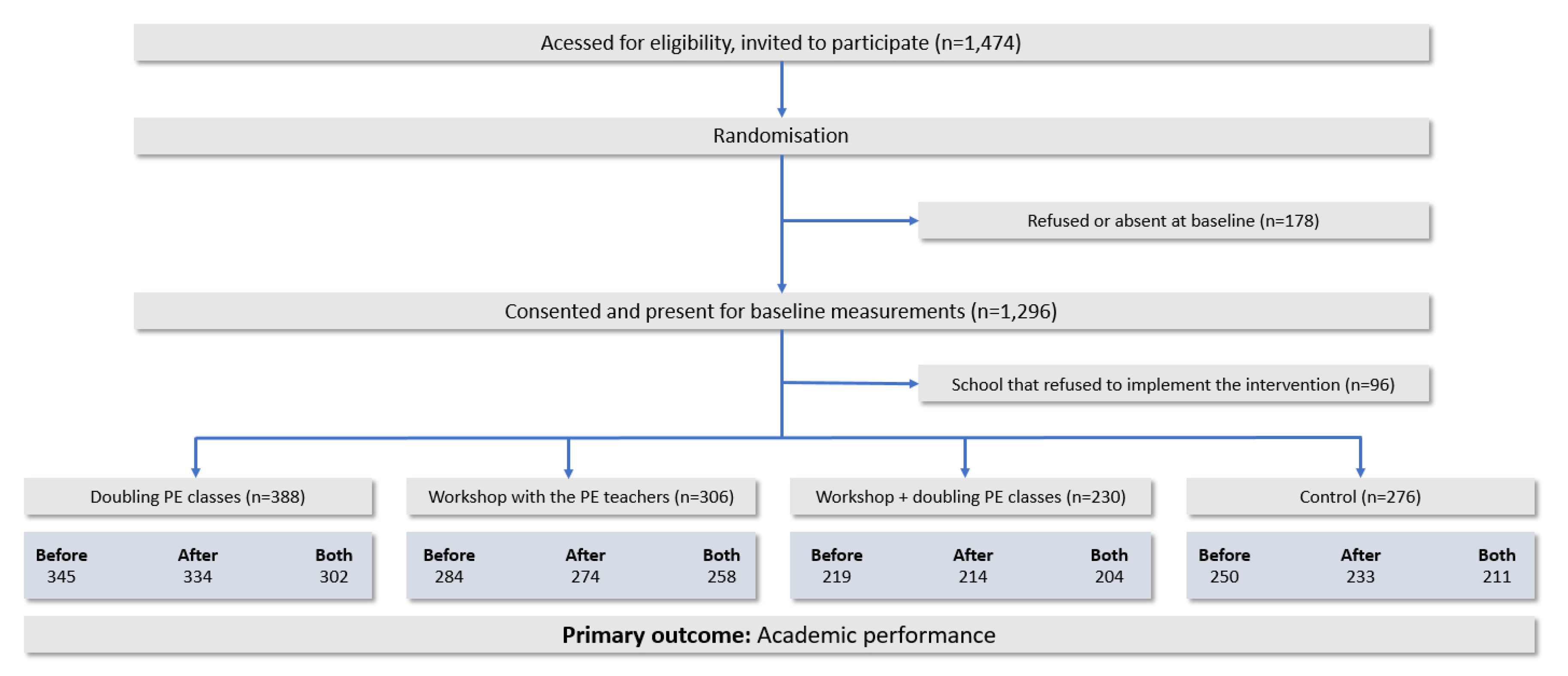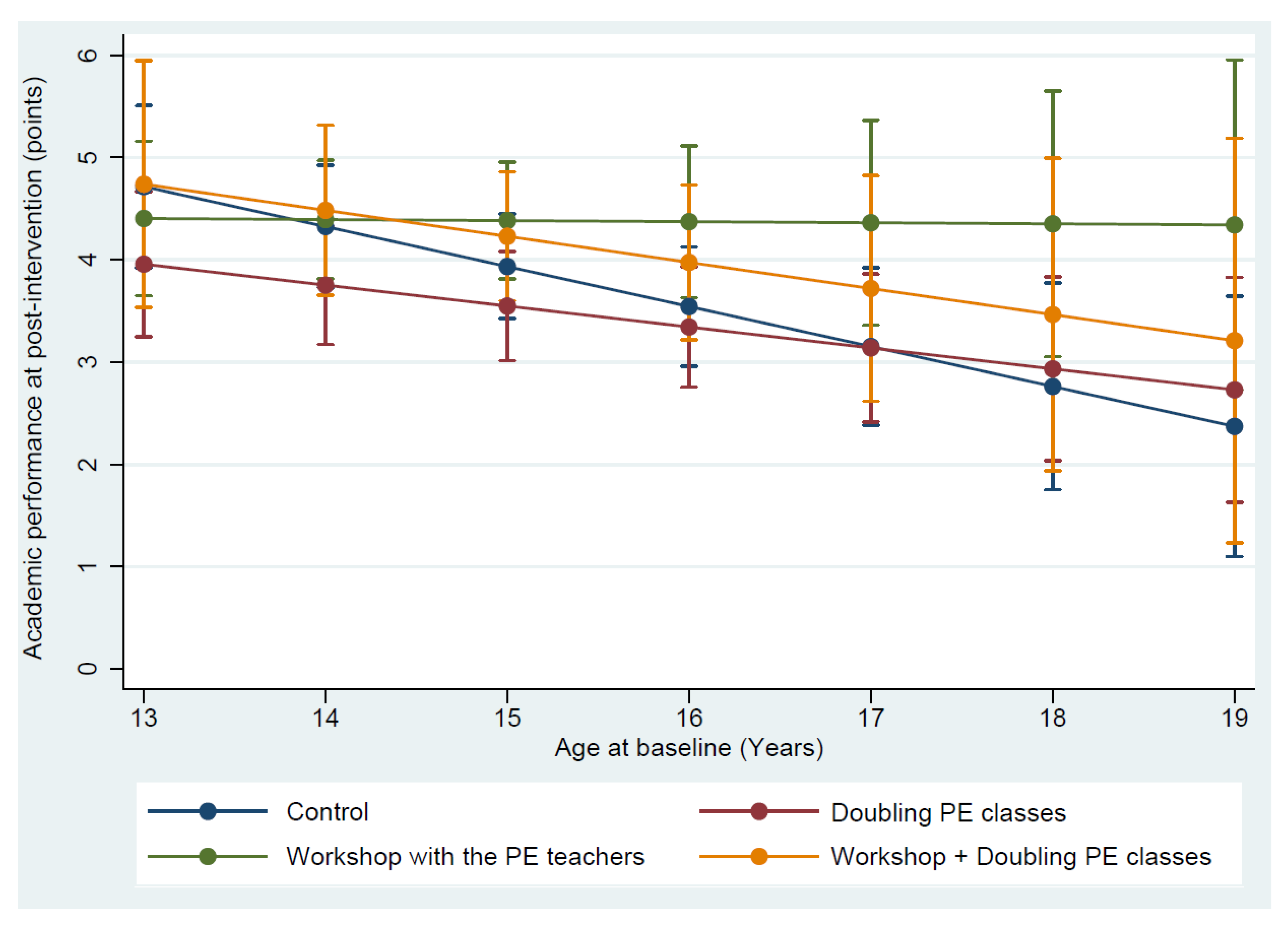Effects of a Physical Education Intervention on Academic Performance: A Cluster Randomised Controlled Trial
Abstract
1. Introduction
2. Materials and Methods
2.1. Randomisation
2.2. Participants
2.3. Intervention
2.4. Measures
2.5. Primary Outcome
2.6. Covariates
2.7. Statistical Analyses
3. Results
4. Discussion
Strengths and Limitations
5. Conclusions
Author Contributions
Funding
Acknowledgments
Conflicts of Interest
Data Availability Statement
Abbreviations
References
- Hills, A.P.; Dengel, D.R.; Lubans, D.R. Supporting Public Health Priorities: Recommendations for Physical Education and Physical Activity Promotion in Schools. Prog. Cardiovasc. Dis. 2015, 57, 368–374. [Google Scholar] [CrossRef]
- Donnelly, J.E.; Hillman, C.H.; Castelli, D.; Etnier, J.L.; Lee, S.; Tomporowski, P.; Lambourne, K.; Szabo-Reed, A.N. Physical Activity, Fitness, Cognitive Function, and Academic Achievement in Children: A systematic review. Med. Sci. Sport. Exerc. 2016, 48, 1197–1222. [Google Scholar] [CrossRef] [PubMed]
- Singh, A.; Uijtdewilligen, L.; Twisk, J.W.R.; Van Mechelen, W.; Chinapaw, M.J.M. Physical Activity and Performance at School. Arch. Pediatr. Adolesc. Med. 2012, 166, 49. [Google Scholar] [CrossRef] [PubMed]
- Fedewa, A.L.; Ahn, S. The Effects of Physical Activity and Physical Fitness on Children’s Achievement and Cognitive Outcomes: A Meta-Analysis. Res. Q. Exerc. Sport 2011, 82, 521–535. [Google Scholar] [CrossRef] [PubMed]
- Chaddock, L.; Erickson, K.I.; Prakash, R.S.; Kim, J.S.; Voss, M.W.; Vanpatter, M.; Pontifex, M.B.; Raine, L.B.; Konkel, A.; Hillman, C.H.; et al. A Neuroimaging Investigation of the Association between Aerobic Fitness, Hippocampal Volume, and Memory Performance in Preadolescent Children. Brain Res. 2010, 1358, 172–183. [Google Scholar] [CrossRef] [PubMed]
- Sibley, B.A.; Etnier, J. The Relationship between Physical Activity and Cognition in Children: A Meta-Analysis. Pediatr. Exerc. Sci. 2003, 15, 243–256. [Google Scholar] [CrossRef]
- Lima, R.A.; Larsen, L.R.; Bugge, A.; Andersen, L.B. Physical Fitness Is Longitudinally Associated With Academic Performance During Childhood and Adolescence, and Waist Circumference Mediated the Relationship. Pediatr. Exerc. Sci. 2018, 30, 317–325. [Google Scholar] [CrossRef] [PubMed]
- Lima, R.A.; Pfeiffer, K.A.; Møller, N.C.; Andersen, L.B.; Bugge, A. Physical Activity and Sedentary Time Are Positively Associated With Academic Performance: A 3-Year Longitudinal Study. J. Phys. Act. Health 2019, 16, 177–183. [Google Scholar] [CrossRef] [PubMed]
- Lima, R.A.; Stodden, D.F.; Pfeiffer, K.A.; Larsen, L.R.; Barros, M.V.G.; Bugge, A.; Andersen, L.B. Dynamic balance, but not precision throw, is positively associated with academic performance in children. Int. J. Environ. Res. Public Health 2020, 17, 2790. [Google Scholar] [CrossRef]
- Kall, L.B.; Nilssin, M.; Linden, T. The Impact of a Physical Activity Intervention Program on Academic Achievement in a Swedish Elementary School Setting. J. Sch. Health 2014, 84, 473–480. [Google Scholar] [CrossRef]
- Ericsson, I.; Karlsson, M.K. Motor skills and school performance in children with daily physical education in school - a 9-year intervention study. Scand. J. Med. Sci. Sports 2014, 24, 273–278. [Google Scholar] [CrossRef] [PubMed]
- Sallis, J.F.; Lewis, M.; McKenzie, T.L.; Kolody, B.; Marshall, S.; Rosengard, P. Effects of health-related physical education on academic achievement: Project spark. Res. Q. Exerc. Sport 1999, 70, 127–134. [Google Scholar] [CrossRef] [PubMed]
- Bugge, A.; Möller, S.; Tarp, J.; Hillman, C.H.; Lima, R.A.; Gejl, A.K.; Klakk, H.; Wedderkopp, N. Influence of a 2- to 6-year physical education intervention on scholastic performance: The CHAMPS study-DK. Scand. J. Med. Sci. Sports 2018, 28, 228–236. [Google Scholar] [CrossRef] [PubMed]
- Telford, R.D.; Cunningham, R.B.; Fitzgerald, R.; Olive, L.S.; Prosser, L.; Jiang, X.; Telford, R.M. Physical Education, Obesity, and Academic Achievement: A 2-Year Longitudinal Investigation of Australian Elementary School Children. Am. J. Public Health 2012, 102, 368–374. [Google Scholar] [CrossRef]
- Coe, D.; Pivarnik, J.; Womack, C.; Reeves, M.; Malina, R. Effect of Physical Education and Activity Levels on Academic Achievement in Children. Med. Sci. Sport. Exerc. 2006, 38, 1515–1519. [Google Scholar] [CrossRef]
- Ahamed, Y.; Macdonald, H.M.; Reed, K.; Naylor, P.-J.; Liu-Ambrose, T.; McKay, H. School-Based Physical Activity Does Not Compromise Children’s Academic Performance. Med. Sci. Sport. Exerc. 2007, 39, 371–376. [Google Scholar] [CrossRef]
- Resaland, G.K.; Aadland, E.; Moe, V.F.; Aadland, K.N.; Skrede, T.; Stavnsbo, M.; Suominen, L.; Steene-Johannessen, J.; Glosvik, Ø.; Andersen, J.R.; et al. Effects of physical activity on schoolchildren’s academic performance: The Active Smarter Kids (ASK) cluster-randomized controlled trial. Prev. Med. 2016, 91, 322–328. [Google Scholar] [CrossRef]
- Tarp, J.; Domazet, S.L.; Froberg, K.; Hillman, C.H.; Andersen, L.B.; Bugge, A. Effectiveness of a School-Based Physical Activity Intervention on Cognitive Performance in Danish Adolescents: LCoMotion-Learning, Cognition and Motion—A Cluster Randomized Controlled Trial. PLoS ONE 2016, 11, e0158087. [Google Scholar] [CrossRef]
- Hollar, D.; Messiah, S.E.; Lopez-Mitnik, G.; Hollar, T.L.; Almon, M.; Agatston, A.S. Effect of a two-year obesity prevention intervention on percentile changes in body mass index and academic performance in low-income elementary school children. Am. J. Public Health 2010, 100, 646–653. [Google Scholar] [CrossRef]
- Johnson, S. Pollard Niklas Trio Wins Economics Nobel for Science-Based Poverty Fight—Reuters. Available online: https://www.reuters.com/article/us-nobel-prize-economics/trio-wins-economics-nobel-for-science-based-poverty-fight-idUSKBN1WT17L (accessed on 15 October 2019).
- Harrison, D.; Hannon, P. Nobel Prize in Economics Awarded for Work on Poverty—WSJ. Available online: https://www.wsj.com/articles/nobel-prize-in-economics-awarded-11571046679 (accessed on 15 October 2019).
- Kremer, M. Randomized Evaluations of Educational Programs in Developing Countries: Some Lessons. Am. Econ. Rev. 2003, 93, 102–106. [Google Scholar] [CrossRef]
- World Bank Group. World Development Report: Learning to Realize Education’s Promise; World Bank Group: Washington, DC, USA, 2018. [Google Scholar]
- Ministry of Education of Brazil Matrizes e Escalas—Instituto Nacional de Estudos e Pesquisas Educacionais Anisio Teixeira (INEP). Available online: http://portal.inep.gov.br/educacao-basica/saeb/matrizes-e-escalas (accessed on 3 June 2019).
- Stearns, E.; Moller, S.; Blau, J.; Potochnick, S. Staying Back and Dropping out: The Relationship between Grade Retention and School. Sociol. Educ. 2007, 80, 210–240. [Google Scholar] [CrossRef]
- Chohan, B.I.; Qadir, S.A. Self-Esteem of the Repeaters: A Mixed Method Study of Elementary Grade Students. Pak. J. Psychol. Res. 2013, 28, 277–296. [Google Scholar]
- Crosnoe, R. High School Curriculum Track and Adolescent Association with Delinquent Friends. J. Adolesc. Res. 2002, 17, 143–167. [Google Scholar] [CrossRef]
- Miller, S.R. Shortcut: High School Grades As a Signal of Human Capital. Educ. Eval. Policy Anal. 1998, 20, 299–311. [Google Scholar] [CrossRef]
- Booth, J.N.; Leary, S.D.; Joinson, C.; Ness, A.R.; Tomporowski, P.D.; Boyle, J.M.; Reilly, J.J. Associations between Objectively Measured Physical Activity and Academic Attainment in Adolescents from a UK Cohort. Br. J. Sports Med. 2014, 48, 265–270. [Google Scholar] [CrossRef]
- Mullender-Wijnsma, M.J.; Hartman, E.; De Greeff, J.W.; Bosker, R.J.; Doolaard, S.; Visscher, C. Improving Academic Performance of School-Age Children by Physical Activity in the Classroom: 1-Year Program Evaluation. J. Sch. Health 2015, 85, 365–371. [Google Scholar] [CrossRef]
- Donnelly, J.E.; Greene, J.L.; Gibson, C.A.; Smith, B.K.; Washburn, R.A.; Sullivan, D.K.; DuBose, K.; Mayo, M.S.; Schmelzle, K.H.; Ryan, J.J.; et al. Physical Activity Across the Curriculum (PAAC): A Randomized Controlled Trial to Promote Physical Activity and Diminish Overweight and Obesity in Elementary School Children. Prev. Med. 2009, 49, 336–341. [Google Scholar] [CrossRef]




| Date of the Sessions | Topics | |
|---|---|---|
| Pedagogical | Health-Related | |
| 2 June, 2017 | Current scenario and future prospects of the physical education in Brazil | Physical activity and physical fitness in the physical education classes |
| 30 June, 2017 | Challenges in the physical education classes in high school | Sedentary behaviours |
| 28 July, 2017 | Designing objectives and selecting topics (educational contents) | The teenage brain |
| 1 September, 2017 | The importance of methodological strategies and process evaluation | Mental health and psychosocial stress indicators |
| 22 September, 2017 | The importance of the motivational atmosphere and the perceived competence for the development and learning processes | Health eating and sleep quality |
| 27 October, 2017 | Session for receiving feedback on the teachers’ experiences regarding the implementation and development of the contents in the PE classes | |
| Title | Doubling PE Classes | Workshop with the PE Teachers | Workshop + Doubling PE Classes | Control | Total | p |
|---|---|---|---|---|---|---|
| Age, in years Mean (SD) | 15.08 (1.19) | 14.66 (0.97) | 15.07 (0.76) | 15.15 (1.02) | 14.99 (1.04) | <0.001 * |
| Female | 201 (51.80) | 177 (57.84) | 133 (57.83) | 166 (60.14) | 677 (56.42) | 0.149 § |
| <8 years of maternal education | 139 (41.49) | 93 (34.07) | 84 (39.62) | 108 (43.55) | 424 (39.70) | 0.130 § |
| Intervention Group | Academic Performance at Baseline, Mean (SD) | Academic Performance at Postintervention, Mean (SD) | Adjusted Difference in Academic Performance at Postintervention in Relation to the Control Group* | ICC | ||
|---|---|---|---|---|---|---|
| Coefficient | (95% CI) | p | ||||
| Control (n = 188) | 3.50 (1.81) | 3.64 (2.26) | 0.092 | |||
| Doubling PE classes (n = 242) | 3.65 (1.87) | 3.82 (2.16) | −0.355 | (−1.121 to 0.410) | 0.363 | |
| Workshop with the PE teachers (n = 198) | 3.89 (2.08) | 4.45 (2.70) | 0.361 | (−0.387 to 1.110) | 0.345 | |
| Workshop + doubling PE classes (n = 152) | 3.62 (1.93) | 3.80 (2.01) | 0.292 | (−0.496 to 1.079) | 0.468 | |
| Age | Intervention Group | Predicted Academic Performance | (95% CI) | Difference in Relation to the Control |
|---|---|---|---|---|
| 13 | Control | 4.72 | (3.92 to 5.51) | |
| Doubling PE classes | 3.96 | (3.25 to 4.67) | −0.76 | |
| Workshop with the PE teachers | 4.40 | (3.65 to 5.16) | −0.31 | |
| Workshop + doubling PE classes | 4.74 | (3.53 to 5.95) | 0.02 | |
| 14 | Control | 4.33 | (3.73 to 4.92) | |
| Doubling PE classes | 3.75 | (3.17 to 4.33) | −0.57 | |
| Workshop with the PE teachers | 4.39 | (3.82 to 4.97) | 0.07 | |
| Workshop + doubling PE classes | 4.48 | (3.65 to 5.32) | 0.16 | |
| 15 | Control | 3.93 | (3.42 to 4.45) | |
| Doubling PE classes | 3.55 | (3.01 to 4.08) | −0.39 | |
| Workshop with the PE teachers | 4.38 | (3.81 to 4.96) | 0.45 | |
| Workshop + doubling PE classes | 4.23 | (3.60 to 4.86) | 0.30 | |
| 16 | Control | 3.54 | (2.96 to 4.13) | |
| Doubling PE classes | 3.34 | (2.76 to 3.93) | −0.20 | |
| Workshop with the PE teachers * | 4.37 | (3.63 to 5.12) | 0.83 | |
| Workshop + doubling PE classes | 3.98 | (3.22 to 4.73) | 0.43 | |
| 17 | Control | 3.15 | (2.38 to 3.92) | |
| Doubling PE classes | 3.14 | (2.42 to 3.86) | −0.01 | |
| Workshop with the PE teachers * | 4.36 | (3.36 to 5.36) | 1.21 | |
| Workshop + doubling PE classes | 3.72 | (2.62 to 4.82) | 0.57 | |
| 18 | Control | 2.76 | (1.75 to 3.77) | |
| Doubling PE classes | 2.93 | (2.04 to 3.83) | 0.17 | |
| Workshop with the PE teachers * | 4.35 | (3.05 to 5.65) | 1.59 | |
| Workshop + doubling PE classes | 3.47 | (1.94 to 4.99) | 0.70 | |
| 19 | Control | 2.37 | (1.10 to 3.65) | |
| Doubling PE classes | 2.73 | (1.63 to 3.83) | 0.36 | |
| Workshop with the PE teachers * | 4.34 | (2.73 to 5.95) | 1.97 | |
| Workshop + doubling PE classes | 3.21 | (1.23 to 5.19) | 0.84 |
© 2020 by the authors. Licensee MDPI, Basel, Switzerland. This article is an open access article distributed under the terms and conditions of the Creative Commons Attribution (CC BY) license (http://creativecommons.org/licenses/by/4.0/).
Share and Cite
Lima, R.A.; Soares, F.C.; Bezerra, J.; de Barros, M.V.G. Effects of a Physical Education Intervention on Academic Performance: A Cluster Randomised Controlled Trial. Int. J. Environ. Res. Public Health 2020, 17, 4287. https://doi.org/10.3390/ijerph17124287
Lima RA, Soares FC, Bezerra J, de Barros MVG. Effects of a Physical Education Intervention on Academic Performance: A Cluster Randomised Controlled Trial. International Journal of Environmental Research and Public Health. 2020; 17(12):4287. https://doi.org/10.3390/ijerph17124287
Chicago/Turabian StyleLima, Rodrigo Antunes, Fernanda Cunha Soares, Jorge Bezerra, and Mauro Virgílio Gomes de Barros. 2020. "Effects of a Physical Education Intervention on Academic Performance: A Cluster Randomised Controlled Trial" International Journal of Environmental Research and Public Health 17, no. 12: 4287. https://doi.org/10.3390/ijerph17124287
APA StyleLima, R. A., Soares, F. C., Bezerra, J., & de Barros, M. V. G. (2020). Effects of a Physical Education Intervention on Academic Performance: A Cluster Randomised Controlled Trial. International Journal of Environmental Research and Public Health, 17(12), 4287. https://doi.org/10.3390/ijerph17124287








